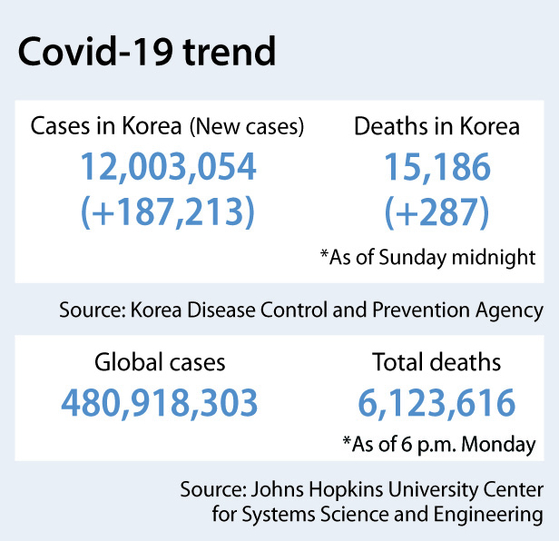Stealth Omicron dominates as infections start to fall
![Merck Sharp & Dohme's oral Covid-19 pill Molnupiravir is stocked at a pharmacy in Seoul on Monday. [NEWS1]](https://koreajoongangdaily.joins.com/data/photo/2022/03/29/be5632fb-0c5d-46df-addb-07ad5cb47bdd.jpg)
Merck Sharp & Dohme's oral Covid-19 pill Molnupiravir is stocked at a pharmacy in Seoul on Monday. [NEWS1]
“The BA.2 type variant [also known as Stealth Omicron] which spreads faster than the existing Omicron variant, became the dominant strain in Korea, with 56.3 percent of new infections last week being BA.2,” said Jeong Eun-kyeong, commissioner of the Korea Disease Control and Prevention Agency (KDCA), at a press briefing at the agency in Cheongju, North Chungcheong, on Monday.
Jeong added that although the weekly infection count -- the total number of infections for an entire week -- dipped last week for the first time in 11 weeks, it is too early to tell if Korea has entered a falling off in Covid-19 infections because of the rise of Stealth Omicron.
“The BA.2 type spreads much faster, and has recently led to a rebound in cases in countries that were thought to have experienced a peak in cases and entered a downward trend,” Jeong said.
Korea added 187,213 new cases as of Sunday midnight, of which 25 were imported, bringing the total tally in the nation to a little over 12 million, according to the KDCA.
Sunday's count was a significant reduction given the daily infections were in the 300,000s for the past two weeks, peaking at 621,328 on March 17.
Korea’s daily infection counts last week were the highest in the world for the third straight week, according to the World Health Organization.
The total last week was around 2.46 million, or around 350,000 cases per day, which was the first time since mid-January that the weekly infection count dropped, according to the KDCA. Omicron became the dominant strain in Korea from late January, replacing Delta. In the first week of January, Korea had an average of 3,679 cases per day.
Some health officials saw the recent drop as the beginning of a downward trend in infections.
“We think the Covid-19 situation in the country may be entering a downward trend after a good portion of the population has been infected,” said Son Young-rae, a senior-ranking official of the Central Disaster Management Headquarters, an inter-ministry body created to respond to the Covid-19 situation, in a press briefing on Monday.
At least 23 percent of Korea’s population were infected with Covid-19 as of Monday, according to the KDCA.
“That, coupled with the high vaccination rate, should lead us to a general reduction in cases,” Son said.
Some 86.7 percent of the population are fully vaccinated, and 63.6 percent have received booster shots, according to the KDCA.

“Last week, 450,000 people aged 60 or above were infected, accounting for 18.4 percent of total infections last week,” Jeong said in the press briefing on Monday. “That is a very worrying number given that elderly patients are more likely to develop severe conditions or even die from infection. We will have to be ready for a spike in number of patients in critical condition and deaths for the next week or two.”
A total of 1,273 people were in critical condition as of midnight Sunday, which was a record high.
A total of 287 people died on Sunday, bringing the total to 15,186 with a death rate of 0.13 percent.
Of last week’s Covid-19 deaths, 95 percent were people aged 60 or above, according to the KDCA.
Jeong added that the government has enough Pfizer's oral Covid-19 medicine Paxlovid to cover 962,000 people and Merck Sharp & Dohme's oral Covid-19 pill Molnupiravir to cover 242,000 people, as of Monday.
"Prescriptions have to be made within the five-day window of symptoms' onset," Jeong said. " Prescriptions should be made first to those in their 60s or above, or those in their 40s with underlying conditions, or those whose immune systems are compromised."
BY ESTHER CHUNG [chung.juhee@joongang.co.kr]










with the Korea JoongAng Daily
To write comments, please log in to one of the accounts.
Standards Board Policy (0/250자)